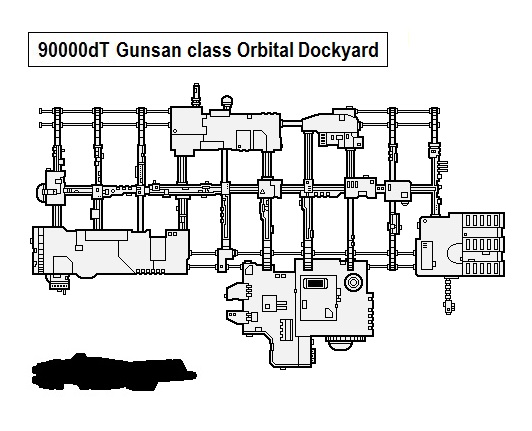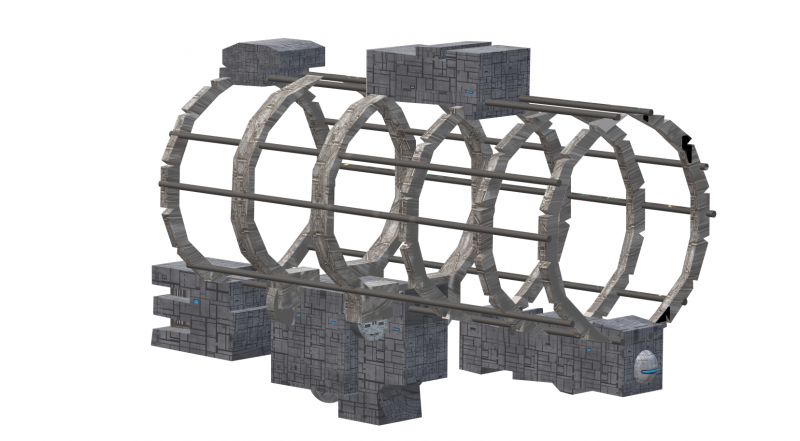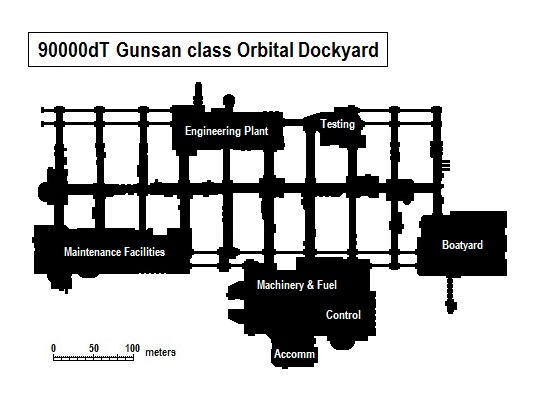Gunsan class Orbital Dockyard
| Gunsan class Orbital Dockyard | |
|---|---|
 Distant Fringe object. | |
| Type: WO Orbital Dockyard | |
| Category | BCS |
| Size | 90,000 Tons |
| Hull Configuration | Dispersed Structure Hull |
| Streamlining | Unstreamlined Hull |
| Tech Level | TL–11 |
| Engineering | |
| Computer | Model/5 |
| Jump | J-0 |
| Maneuver | 0.5 G |
| Armaments | |
| Hardpoints | 900 |
| Accommodations | |
| Staterooms | 0 |
| Personnel | |
| Crew | 516 |
| Officers | 104 |
| Enlisted | 412 |
| High/Mid Passengers | 0 |
| Payload | |
| Cargo | 14,000.0 Tons |
| Fuel tank | 0 Tons |
| Construction | |
| Origin | Distant Fringe |
| Year Operational | Unknown |
| End of Service | Still in active service. |
| Price | |
| Cost | MCr30,060.950 (base) MCr24,048.760 (qty) |
| Architect fee | MCrAde Stewart |
| Statistics | |
| Images | |
| Blueprint | Yes |
| Illustration | Yes |
| Source | |
| Also see | Space Station |
| Canon | Published, fan design |
| Era | 1105 |
| Reference | Fan: Ade Stewart |
| Starships are designed with the Classic Traveller format, using High Guard. | |
The Gunsan class Orbital Dockyard is a large Space Station.
- It is a Civilian Structure and an Orbital Dockyard.
- The dockyard is a TL-11 design.
- They are often associated with Harbor class Orbital Stations.
- Please also see AAB article: Ships of the Distant Fringe.
Description (Specifications)
The Orbital Dockyard is a large commercial orbital facility found within systems in the Distant Fringe region. It is classified as an Orbital Complex. Similar designs have been in use from the time the Distant Fringe was first settled.
Image Repository
- A Gunsan class Orbital Dockyard with an Olympian class Cruise Liner (silhouetted) alongside.

- Beside a Gunsan class Orbital Dockyard. As is common with this design, the factory components are located around the exterior of the construction cylinder according to the operators preferences.

General Description
The dockyard is constructed as a Dispersed Structure. The core of the station is the yard space, an empty cylinder surrounded by joined rings with an enclosed volume of approximately 1.3 million dTons. Sections within this cylinder are set aside as maintenance facilities, an engineering plant, and an equipment testing facility: each area has multiple hangars and sealed compartments. Individual dockyards contain the same basic elements but their layouts may vary considerably, depending on the needs and preferences of the operator.
The main section of the dockyard is a boxy structure built onto the exterior of the rings. It contains much of the heavy machinery, the operations control center, and the crew and passenger accommodations. An enclosed boatyard is set aside for the manufacture of smaller starships and smallcraft.
Each area of the dockyard can be accessed by transportation pods that follow trackways mounted on the interior of the yard rings. All sections of the yard can also be accessed by internal walkways, though many areas have no grav plates and some sections may not be pressurized.
The dockyard mounts x80 Heavy Repulsor units in bays spread over the interior of the yard space rings. These are used as construction tools, working in groups to maneuver and manipulate very large components.

A basic plan of the station indicating the general layout and positioning of major elements.
Basic Ship Characteristics
Following the Imperial Navy and IISS Universal Ship Profile and data, additional information is presented in the format shown here. The small craft factor indicates the number of squadrons (of ten craft) carried on the ship. Tonnage on the universal ship profile is shown in kilotons (thousands of tons) where necessary. [1]
| Basic Ship Characteristics [2] | ||
|---|---|---|
| No. | Category | Remarks |
| 1. | Tonnage | The Orbital Dockyard is constructed using a 90,000 dTon hull built in a dispersed structure configuration. The hull is unstreamlined and cannot survive entry into a planetary atmosphere.
|
| 2. | Crew | Total Crew Complement: 516
Accommodations:
Accessible areas of the hull are fitted with grav plates and inertial compensators and have full life support and environmental systems.
|
| 3. | Performance | The dockyard mounts a Maneuver half-drive, and a Power Plant-1, giving performance of 0.5-G acceleration (sufficient for orbital positioning only) and producing 900 Energy Points. The dockyard does not have an agility rating. The dedicated internal fuel tankage gives the power plant 4 weeks duration.
|
| 4. | Electronics | Adjacent to the bridge is a Model/5 Computer: the dockyard has x3 backup Model/5 Computers.
|
| 5. | Hardpoints | x900 hardpoints.
|
| 6. | Armament | The dockyard is unarmed. |
| 7. | Defenses | The hull is unarmored.
x80 100-Ton bays, mounting Repulsors. The Repulsors face inward and are used as construction tools, using gravitic forces to manipulate and maneuver large components. The dockyard is not fitted with screens or other passive defensive systems. |
| 8. | Craft | The dockyard is not supplied with intrinsic subcraft: these are purchased as required by the yard's operators.
Hangars |
| 9. | Fuel Treatment | The dockyard has dedicated internal fuel tankage of 900 dTons.
The yard has auxiliary fuel tankage of 2,600 dTons, sufficient to provide an operational supply of fuel to vessels berthed within it.
|
| 10. | Cost | The basic cost of the station is MCr30,060.950
|
| 11. | Construction Time | 205 weeks (51 months) as standard.
|
| 12. | Comments | Standard cargo capacity amounts to 14,000 dTons. Some of this space is occupied by specialist manufacturing equipment and machinery, though much holds preassembled ship components and fittings and a range of raw and processed materials necessary to the construction process.
|
History & Background (Dossier)
Gunsan class Orbital Dockyards are rugged and known for their excellent safety record. The design is representative and a large number of variants exist, particularly with regard to the onboard electronics and the fit out of internal spaces.
Support Craft
The station relies on a variety of support craft.
Interface Craft:
Tankers:
Distant Fringe Vessels
The Distant Fringe is said to be a far rimward-trailing area inhabited by colonists and refugees originating on Terra. The region is extremely isolated, lying hundreds of parsecs from the rest of Charted Space and separated from it by almost uncrossable rifts that were once broached by a system of calibration Points and the use of tankers. Those few academics within Charted Space who have found references to the Distant Fringe regard it as little more than a tall tale. Likewise, many of the inhabitants of the Distant Fringe believe the existence of Charted Space to be mythical.[3]
Vessels originating within the Distant Fringe are very rarely encountered outside of the region. However, misjumps do occur and anomalies with bizarre spacetime and Jumpspace effects exist: as such, craft of this type are not entirely unknown within Charted Space. Data about stations and facilities may be known from records found aboard such far-flung craft.[4]
Class Naming Practice/s & Peculiarities
A number of companies manufacture facilities equivalent to the Gunsan class dockyard.
They vary in hull shape and internal layout but all share the same basic design and all have very similar capabilities and performance characteristics
- Each variant class of yard is named by the company that produces it: these organizations generally draw on traditional naming protocols. It is not uncommon for a historical class name to be reused.
- Individual stations within a class are issued specific designations.
Selected Variant Types & Classes
Artificial Satellites – Space Stations:
References & Contributors (Sources)
| This article has metadata. |
| This article is missing content for one or more detailed sections. Additional details are required to complete the article. You can help the Traveller Wiki by expanding it. |
- Marc Miller, Frank Chadwick, John Harshman. High Guard (Game Designers Workshop, 1980), 20-37. (Design Sequence Used)
- Traveller Wiki Editorial Team
- Author & Contributor: Lord (Marquis) and Master Scout Emeritus Adie Alegoric Stewart of the IISS
- Author & Contributor: Lord (Marquis) and Master of Sophontology Maksim-Smelchak of the Ministry of Science
- ↑ Timothy B. Brown. Fighting Ships (Game Designers Workshop, 1981), 10.
- ↑ Timothy B. Brown. Fighting Ships (Game Designers Workshop, 1981), 10.
- ↑ Information provided to the library by Maksim-Smelchak
- ↑ Information provided to the library by Maksim-Smelchak